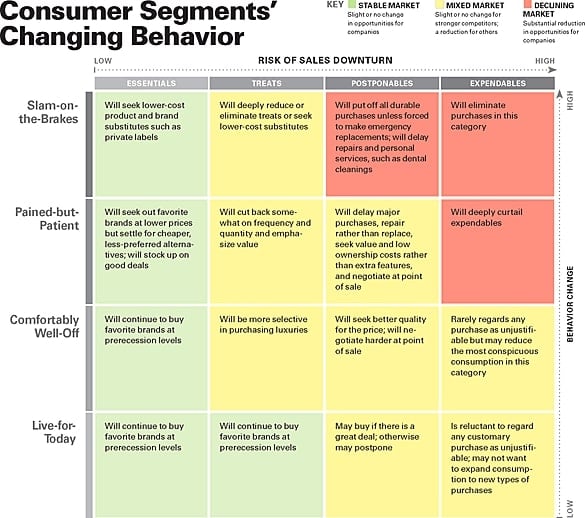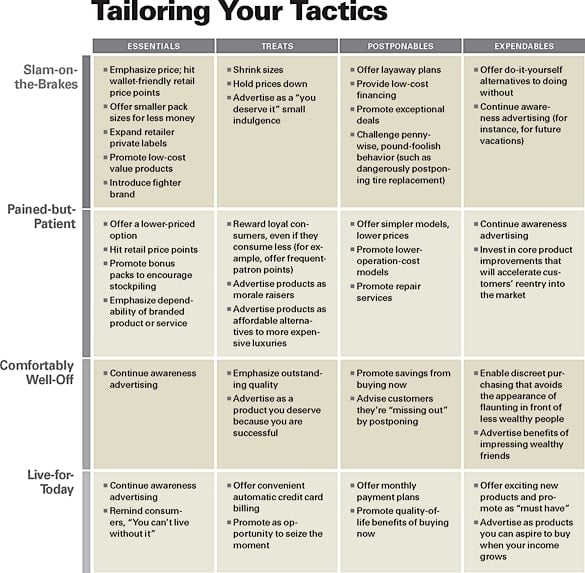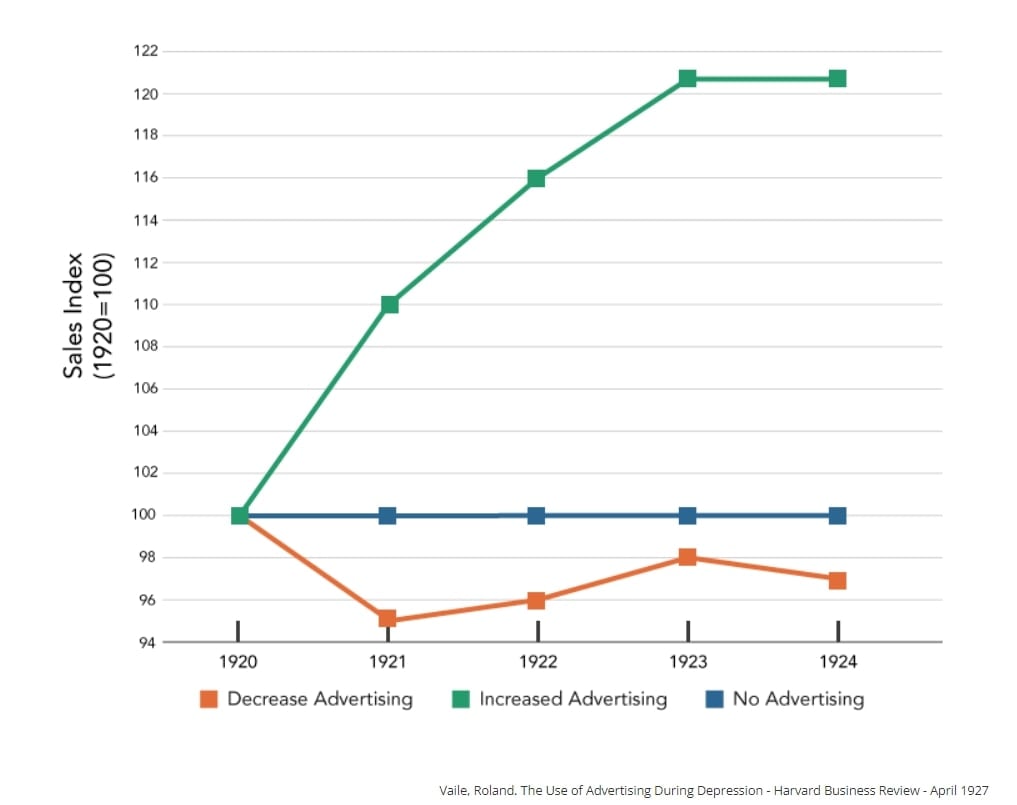‘Many people think that lean is about cutting heads, reducing the workforce or cutting inventory. Lean is really a growth strategy. It is about gaining market share and being prepared to enter in and gain new markets.’
— Ernie Smith, Lean Enterprise Forum at the University of Tennessee
Good marketing is lean marketing. And, it’s recession-proof.
In this article you will find:
- The answer to ‘What is lean marketing?’
- What we’ve learned about marketing in a recession
- How to improve operational efficiency
- Which vanity projects to eliminate
- The most profitable marketing activities
Here’s why it matters. Operate lean as a baseline so when times are tough, you will have had the practice you need to be more agile and resilient than competitors.
What is lean marketing?
Lean marketing is the principle of achieving your business’s marketing goals while remaining as efficient as possible. A balancing act between effort and return, in other words. It’s not about doing more with less, but about finding the most profitable, most effective activities, strategies and processes. Then, focusing on optimising those efforts. The right resources, used judiciously, while measuring results. That’s what it means to be lean.
Important caveat: You want your marketing budget to be lean, not starved and unable to sustain itself. As you can probably anticipate, that would cause a cascade of issues throughout your pipeline and will undermine your future revenue. Conversely, you also can’t expect to throw money at the problem and see instant results.
-1.jpg?width=1000&height=1000&name=High%20effort%20+%20Low%20profitability%20(1)-1.jpg)
In terms of this diagram, to be lean, we want everything to land in the upper right quadrant, right? Low effort. High profitability.
Nice.
That’s not always going to be the case, but sorting your activities into where you think they’d sit in these four categories can be a good way to prioritise and climb the stairway to lean marketing heaven (where all that glitters is gold).
To do lean marketing right, then, you need to focus on the gap between effort and return. Where is that gap the widest? Does 50 percent more budget lead to 50 percent return? Less? More?
You could spend the bare minimum and you’ll likely get the bare minimum in return. Or, as we’ve said, you could put in the maximum effort and buckets of resources. That may well increase your chances of success. However, you’ll likely find you hit diminishing returns at some stage. The proportions of effort to outcome get smaller, in other words. Pay attention to that. It may be a sign to reallocate resources to a higher yield activity.
When you’re ambitious, it’s tempting to say, “There’s so much more we could be doing”. Of course there is. But don’t let perfection get in the way of good enough. To be lean, aim for the best possible return, not the best possible outcome.
We know this is the right way to think about your marketing budget because we’ve seen this play out across history, and for our own clients as a marketing agency. We’ve weathered a few recessions ourselves by operating on a lean basis.
Lest history repeat itself — as it is wont to do — let’s now take a look at how businesses have responded to bad times (read: recession) in the past. There are lessons worth learning, and examples worth avoiding.
What we’ve learned about marketing in a recession
In the year after the 2008 financial crisis, Harvard Business Review posted a much-copied, much-admired article called ‘How to Market in a Downturn.’ In it, the authors say:
‘Companies that put customer needs under the microscope, take a scalpel rather than a cleaver to the marketing budget, and nimbly adjust strategies, tactics, and product offerings in response to shifting demand are more likely than others to flourish both during and after a recession.’
The article then breaks down consumer buying habits into these categories:

Hat tip: HBR
And suggests these tactics to compensate:

Hat tip: HBR
They go on to say businesses from computer manufacturer Dell to luxury jeweller De Beers used this way of thinking to not only survive, but thrive on budget. Meaning, they invested at just the right moment in ad spend and targeted messaging. They spoke to changing consumer attitudes and spending habits. They said the right things, to the right people at the right time. As such, they snatched a huge share of the market. Diamonds are forever…
Around the same time as that article came out, The New Yorker produced their own take: ‘Hanging Tough’. They referenced Post vs. Kellogg’s, an example from the Great Depression. During this period, Kellogg’s doubled down on marketing spend, with radio ads and new product lines (hello Rice Krispies). Post cut spending on marketing and product development. Of course, many years later, and many recessions later, Kellogg’s stands strong as the market leader in the cereal industry. Go figure.
In fact, that story represents a common theme for recession-era marketing. Break out a copy of the HBR from April 1927 (or keep reading) and you’ll see research done by Roland Vaile and Reavis Cox on the recession in the 1920s found that of 250 companies that were studied, those that invested in their marketing performed better during and after the recession:

Hat tip: Innovation Visual
Since then, dozens of empirical studies have come out supporting the case for targeted marketing and even increasing marketing spend during tough times. Stephen King (not that one) and Alex Biel recreated these results in 1990, finding a correlation between marketing spend and the opportunity to grow market share in the long term.
‘Marketers increasing their spending by an average of 48 percent during a recession win virtually double the share gains… [Though this tactic is associated with a] drop in return on investment of 2.7 percent in the short term, it may nevertheless be acceptable to the marketer looking ahead to post-recession growth.’
And, to return full circle to 2008, HBR’s study of 4700 companies found that after three years:
- Seventeen percent of businesses didn’t survive at all.
- Eighty percent of survivors had not yet regained their prerecession growth rates for sales and profits three years after a recession.
- Only nine percent of survivors flourished after an initial slowdown, increasing profits in real terms and outperforming rivals in their industry by at least 10 percent. Worth noting, firms that had cut costs actually had the lowest chance of ending up in this category.
The flourishers were found to ‘deploy a specific combination of defensive and offensive moves’ which meant they had ‘the highest probability of breaking away from the pack.’ These companies did three things:
- Focused more (and more quickly) on operational efficiency than their rivals.
- Diverted resources to a select range of targeted activities and projects with provable ROI.
- Invested comprehensively in the future by spending on marketing, R&D and new assets.
This final example rather reinforces King and Biel’s conclusion. In 2008, Sony announced it would cut costs by 2.6 billion USD, closing factories and making a large portion of its workforce, redundant. It slashed research and development spend. It cut overall spend, including marketing, by a quarter. And yes, Sony increased its profit margin to 12 percent. Briefly.
However, that profit margin took a nose-dive throughout the decade from the 2008 crash, with an average one percent net profit margin in that period, with two of those years spent in the negative. During that slow crawl to recovery, competitors like Amazon pulled ahead, growing sales by 28 percent.
Humbly, and with the weight of a hundred years of research and not a few recessions behind us, we suggest you invest in your marketing during bad times. Don’t be Sony. And don’t start a race to the bottom in terms of your pricing, either. Focus on your audience, on your people, on their needs and goals. Remember that first HBR article we talked about? Well it concludes with this prediction:
‘The shock of the downturn and anger accelerated a resentment of cynical marketing that treats people as soulless and mechanical consumers… Customers will demand that business act in their and society’s best interests and will factor company practices into their brand choices.’
Over the last decade, with the meteoric rise of the global B Corp movement and 80 percent of the UK public saying they favour buying from sustainable brands, that prediction seems to hold water. More on this in a minute.
Be the lean marketing machine that cuts precisely, focuses on key activities, invests strategically and operates in society’s best interests. Hold fast in tough times and you will join the ranks of those businesses that flourish in the long term.
Based on the three points from earlier, here are the steps you need to take:
1. Improve your operational efficiency
Be sustainable
You want to build a sustainable business for any number of reasons. By sustainable, we literally mean a business that will succeed in the long term and will therefore, necessarily, have a positive impact on customers, employees and the planet. In other words, the triple bottom line: profit, people and planet.
Try to ensure you have at least six months’ cash flow as a safety net for your business and for your employees. Invest in said employees, in their training, in their skills, so you can be more innovative and potentially open up new revenue streams based on that knowledge. And find the opportunities in your business to align cost-cutting with positive environmental impact. For example, cut the commute and have that meeting via video conference. These are the types of companies that customers want to buy from: good for the planet, good for your pocket.
Work from home
Speaking of which, stay home! Or embrace hybrid. There are arguments that some in-person time can be benficial for creativity and collaboration, so of course, work on whatever basis suits your needs. Again, it’s all about balance. Saying that, running an office is a big expense. If you can cut it out altogether, or reduce your office size by doing your marketing from home, you’ll save without losing out. In fact, you may stand to benefit in terms of talent acquisition and employee satisfaction.
Use lean and agile processes
Ninety-five percent of organisations use Agile or Lean ways of working somewhere in their business, so you’re more than likely doing this already. Now is the time to align more of your departments to this way of working. It’s not just the production team that can be agile. So can marketing, sales and customer success. Read more about agile marketing, here.
Consolidate your tool stack
Technology will unlock greater opportunities for automation and better, more efficient processes. In terms of the marketing department, consider moving all your contact data to a central Customer Relationship Management (CRM) hub with built-in marketing and sales tools. That way, there are no hidden costs. It’s one subscription for one comprehensive suite of tools.
At the very least, audit your existing tech stack. It will take you just a few hours and could be the most profitable thing you do all year. Make sure you’re not accidentally paying for unnecessary tools. We did this at Articulate and saved a whopping 30 thousand pounds over two years. Seriously.
Measure what matters
You can’t tell how profitable an activity is without the means to measure it. Use reporting tools, Key Performance Indicators and set goals so you have a good understanding of what success looks like. Then, you can start to compare the ROI of one activity versus another, and do more of what works.
Outsource
There are plenty of reasons to hire an agency for your marketing, but we’ll highlight two here. The first is that it makes you more agile as a business because you can turn the tap up or down as needed. Meaning, you get the power of a whole marketing team when you need it as opposed to hiring, training and looking after all those people in-house, year-round.
The second reason is strategic. One hour of expert consultation could quite literally save you weeks of pain and lost profit. Sometimes, you just need someone to point you in the right direction.
2. Eliminate vanity projects
Resist the ‘me me me’
Newsflash: your audience doesn’t care about you. Harsh, but hear us out. What your prospects DO care about, like everyone else, are their problems, their goals, their stories. They are the main character. You need to position yourself as the helpful guide on their quest. The person that provides precisely what they need to slay dragons and win glory.
That means ditching the BOFU-first approach. BOFU means ‘bottom-of-funnel’, which is the marketing you do where you talk about your products, your services, your business, your features and benefits and company news and all that. Dramatically reduce your effort here. Displace it with TOFU activities. Top-of-funnel. Do marketing that speaks to what they care about in their language. More on this in section three where we talk about profitable marketing activities.
Cut lavish events
Everyone loves a party but no one wants to pay for it. And, no one wants to stick around after to tidy up.
Once upon a time, in-person events, conferences, talks and Mad Men-style dinners were much more a part of the whole marketing and sales shtick. Now, in a post-COVID era, with the rise of digital marketing, such events are usually a luxury, not a necessity. Again, this differs across industries, but it’s a good rule of thumb.
Avoid chasing fame
The chances of you ‘going viral’ are… zero. Well, close to zero. And virality is one heck of a basket in which to place ALL of your eggs. Engaging a PR or media firm that promises fame, fortune and the front of Times Magazine is not going to be the best way to spend your budget. There is no magic bullet for this stuff.
Don’t waste time on the wrong metrics
There are metrics and there are vanity metrics. Social media engagement. Comments. Likes. On the face of it, they may seem useful. But don’t waste your time on metrics unless you plan on using them to take action. Or, don’t double measure, for example, by looking at metrics like bounce rate where time on page measures much the same thing. We suggest focusing on tangible things that inform a particular insight or spur action, such as traffic and conversion rates.
Curb your (Google) ad spend
Don’t, for the love of all that is holy, waste your money on the endless pit of Google Ads. In our experience with B2B tech firms — and of course, Google will never tell you this — Google Ads are a great way to burn cash. If you want to do pay-per-click advertising, try LinkedIn instead.
Stop yearning for the past
The SEO game is constantly changing and Google’s algorithms are capricious. Chances are, you’ve seen some unwelcome fluctuations in website traffic after at least one of the company’s many updates.
Alternatively, maybe you used to get loads of customers from referrals or vendors, and now they’ve all dried up. Or the economy crashed and all your leads have become spend-thrifts. Whatever.
You can fire your marketer and spend all your energy scrabbling to regain what’s been lost. Or. You can put the past behind you, look ahead and set your goals based on the current reality, not what was true when you were young and beautiful and a Freddo cost 10 pence.
Brutal, but it had to be said.
3. Do these profitable marketing activities
Make adjustments, carefully
OK, we’re not saying fundamentally alter your brand’s positioning or products. But do sit down and consider what you might need to adjust. We said ‘bad times’ but we didn’t say what kind of bad times - pandemic, recession, global conflict and so on. You can’t possibly be prepared for every eventuality, but you can react quickly in unprecedented times. Your tone of voice should reflect current events, on your website, on social media. Perhaps your audience’s attitudes have changed, so consider how to talk to this new perspective. What do people care about now?
If you change too much you may alienate or confuse existing customers, but there is room to pivot where necessary.
Cultivate your brand
By this we mean, tell the story you’re telling, but do it better. Find the pithiest, truest thing about your business, which is probably something you already say and do, and build a story (and a style) around that.
For example, we did this for HTG. Instead of being any old IT company, now they sell the dream of how IT services are part of your bigger business ‘wins’. The language of winning then extended to their website, where we created storylines for their services based on what ‘winning’ looks like to their audience, such as ‘enabling remote work’ or ‘meeting sustainability goals’. All of a sudden, they’re an aspirational partner, not a service provider.
Update your website
There are good ways to do this and bad ways to do this. The bad way is spending loads of money and time on endless design iterations, only to end up with a slow website that doesn’t convert any leads.
The good way is to build a quick, clean launchpad website based on best practices, then use it as the foundation for further activity. This forms your playground to test things, like calls-to-action, and make data-based changes.
Launch something
Bad times happen; lipstick sales rise. This is such a known phenomenon that there’s a name for it: The Lipstick Effect. Meaning, people are buying small luxuries, like lipstick, instead of big ones, like going on holiday.
Now in the B2B world, you’re not selling lipstick. But you could learn this lesson from your B2C chums. Launch something smaller or cheaper. Repackage existing services with new messaging for the current climate. Offer early access to a beta product.
There are two key times to do this in a recession: early, when people are starting to get nervous about spend and are researching cheap alternatives, and late, when people are feeling more confident and are interested in new and shiny innovations.
Marketers call this a ‘fighter product’. It’s not selling yourself short, or reducing margins, or slapping a ‘20 percent off’ sticker on everything. It’s triaging your services and products and finding or building something with maximum profitability and timeliness in mind, then promoting the heck out of it.
Do inbound marketing
Inbound marketing is cheaper than outbound marketing at about 60 percent of the cost per lead. Plus, it’s like renting vs buying a house. With outbound, and with certain activities like advertising, when you stop paying, the leads dry up. Basically, rent. With inbound, by bringing leads to your business through content and gated offers, you are creating a fanbase and growing your SEO profile, brand awareness, thought leadership status and so on, all at the same time. You’re investing in your forever home.
For more advice on this enormous topic, read these 101 B2B lead generation tips for inbound marketing.
Optimise iteratively
Sufficient observation, testing and optimisation means you can build intelligence into your marketing without breaking the bank. Optimise things like conversion rates, over time, using A/B testing. This has the equivalent benefit of turning a capital, up-front expense (such as buying a list of leads) into smaller recurring expenses with predictably positive results.
Leverage existing customers
Repeat business is cheaper than new business. In fact, it’s five times cheaper. So, aim to keep your existing clients by proactively finding opportunities for upsell. And, ask for stuff! For referrals. For case studies and reviews. Social proof is the top consideration for buyers, so you need loyal customers who are willing to provide these kinds of materials. Customer advocacy closes the loop of your sales cycle.
Lean in, make progress
Lean marketing is the harder thing to do, but it’s the right thing to do for your business’s health, longevity and future share of the market.
Resiliency is key. So, embrace these principles and you’ll find yourself in a much better position to weather future storms, or indeed to ride out whatever economic turbulence may be rattling you as you read this. Lean in, make progress and thrive in uncertain times.
Looking for one-to-one advice on marketing best practices? Contact our sales team.

 Posted by
Maddy Leslie
Posted by
Maddy Leslie





.jpg?width=400&height=250&name=europeana-_4qzbkDe834-unsplash%20(1).jpg)

